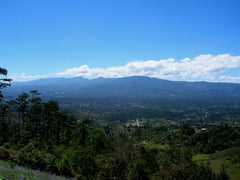
Although it's only a small country approximately the size of Pennsylvania, Honduras is currently #6 of the world's largest coffee exporters. The mountain on which we are located alone has several hundred acres of coffee. The climate is very favorable for raising coffee, with the rainy season not too cold, and the dry season not too dry as to have much negative impact on the coffee production.
At this altitude, our coffee year consists of flowering multiple times between March and May, then fruit development for about 9 months after which the hard green cherry ripens. We begin the first big pickings in December and go over the patch about every 3 weeks until the harvest winds down in March. By then, the plants are flowering again, preparing for the next year's crop. Lower altitudes in the region are a few weeks ahead of us in all stages of development.
What is the advantage of high altitude coffee? Coffee beans grown at higher, cooler elevations develop more slowly than in the lower regions. This forms a smaller, denser bean with a richer flavor than low- and mid-altitude coffees.
